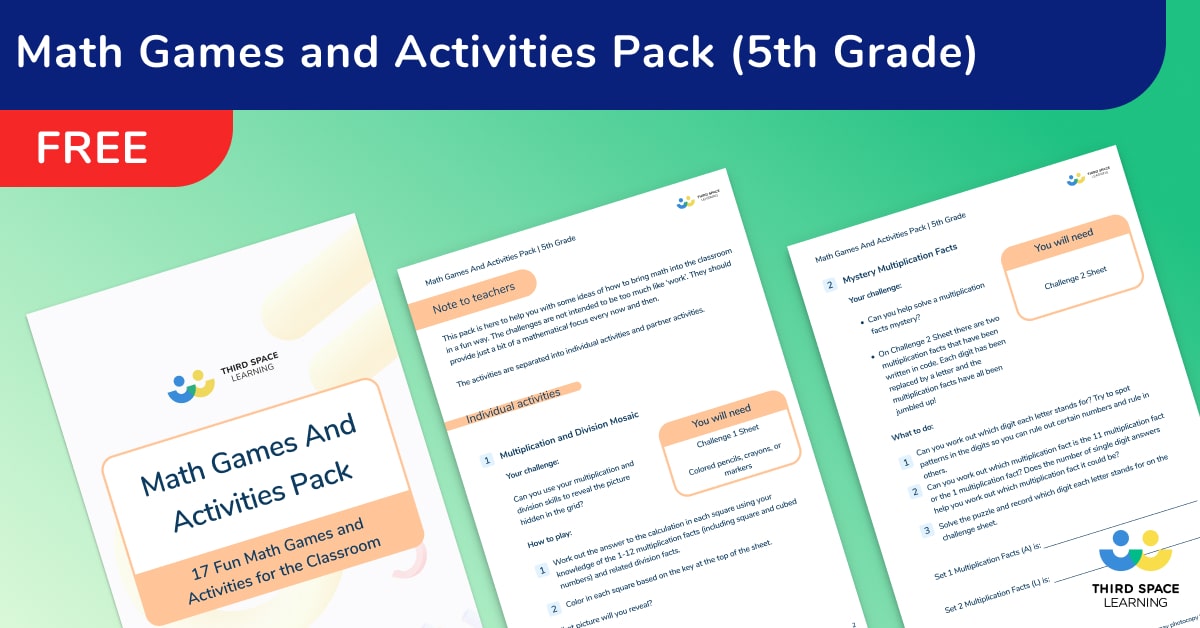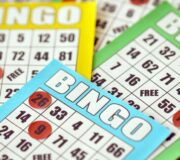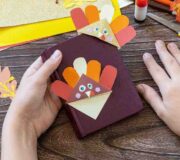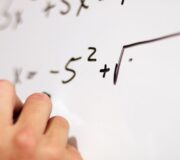Math Games For Your Grade 5 Students: Fun, Free Math Activities (No Screens Required!)
Math games for grade 5 are a great way to vary class time. In 5th grade math, children are expected to work with larger numbers for the 4 operations. They are introduced to algebra and the coordinate plane for the first time, while the concept of numerical patterns is extended. Fifth grade children are also able to cope with slightly more complex game play and games can be a great form of math practice.
When to use math games in fifth grade
Fifth grade is an important year for developing math skills and setting children on the right path before middle school. As lessons can be slightly more rigorous than those of 3rd grade or 4th grade, it’s important to break up lesson time with some fun math activities.
Fifth grade math games can be a great way to start a lesson, get children focused on the material right as they enter the classroom, and they can also be a good lesson closer or exit ticket to summarize the day’s learning.
See also:
17 Fun Math Games and Activities Pack for 5th Grade
Printable math games and activities for your 5th grade students to complete independently or with a partner.
Download Free Now!How to use these 5th grade math games
We hope that this collection of fun math games can be an extra tool in your teaching toolbelt. Repetition is an important part of learning and these free math games provide another opportunity to cover new content as well as revisit past topics in a different way. We hope that these educational games will be enjoyed by you and your young learners.
All games can be modified to cater to different levels, numbers can be simplified by using one or two-digit whole numbers or providing students with a number line, or be made more challenging by incorporating decimal numbers, fractions, mixed numbers, exponents, etc.
Algebra 3 in a row
Algebra is a topic children sometimes perceive to be difficult. This 5th grade math game builds children’s confidence with algebra.
What you will need to play:
- 2 players
- Algebra game board (see downloadable resources)
- Equations list (see downloadable resources)
- 20 counters (2 colors)
- 2 dice (can be just 1)
- Algebra game board and list of equations (shown below)
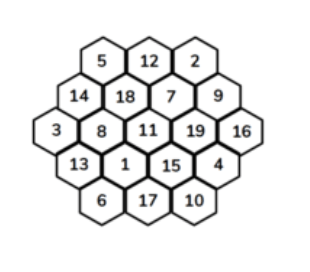
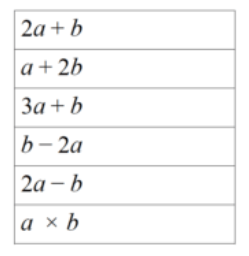
How to play:
- The first player throws both dice.
- With the 2 numbers generated, they decide which number will represent ‘a’ and which number will represent ‘b’
- They then choose one of the 6 equations, using the 2 numbers generated to represent a and b.
- They work out the answer and cover the number with a counter.
- The next player does the same.
- Players take it in turns, until one player has positioned 3 counters in a row. They are the winner.
Countdown
This is a good math game to play with 5th graders. It works well in small groups or as a whole class activity and encourages players to think deeply in order to identify calculations which will get them to the target number.
What you will need to play:
- 2 or more players
- 4 ‘large number’ cards – 25, 50, 75, 100
- 2 sets of 1-10 cards
How to play:
- Set out the large number cards face down in one pile and the small number cards face down in another pile.
- Players take it in turns to choose a card from either the small or the large number piles and place it face down on the table.
- Once there are 6 cards face up on the table, the target number needs to be generated
- The target number can be generated by picking 3 number cards from a pile of 0-9 cards.
- Once the number has been generated, children have 2 minutes to try and reach that total using the 6 cards selected.
- Children can use any calculation using the 6 numbers, but each number can only be used once.
- The winner is the first person to reach the target number or the person to have the closest answer after 2 minutes.
Fractions and decimals game
Fifth graders expand on previous fractions work. They are expected to recognize equivalent fractions and decimals. This game will help children practice this.
What you will need to play:
- 2 players
- A set of fraction and decimal cards (shuffled- see downloadable resources)
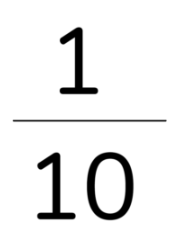

How to play:
- Place the shuffled pile of cards face down on the table.
- Take turns to flip over a card. If 2 cards are turned over with matching fractions/ decimals, e.g. 0.1 and 1/10, then the first player to call out ‘snap’ and put their hand on the pile gets to keep all the cards put down so far.
- The winner is the player at the end of the game with the most pairs of cards.
- This game can be made more challenging by using decimals up to thousandths. This is also good practice for studying place value.
Multiplying fractions game
This is a great game for studying unit fractions. Children can add, multiply, and subtract fractions, giving them lots of practice handling this often challenging topic.
What you will need to play:
- 2 players
- A set of 1-9 cards.
- Blank fractions sheet (see downloadable resources)
- Pen/pencil
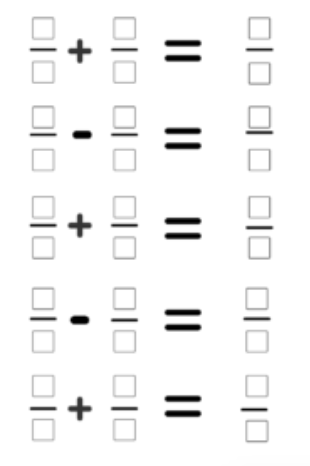
How to play:
- Each player has a blank fractions page.
- Take turns to throw the dice and each player decides which box on their sheet to put the number in
- Once four numbers have been generated and all 4 boxes contain a number, each player multiplies, adds, or subtracts their fractions (vary the operation being used).
- The player who has made the greatest fraction scores 2 points.
- If both players make the same sized fraction, each player scores 1 point.
- The winner is the first player to reach 10 points.
Mental math games
Mental math games are great for practicing a range of mental math concepts, without requiring resources or time to set up. They can be used as a quick warm up at the start of a lesson, a fun way to consolidate learning at the end of a lesson, or as a time filler at any point in the day.
Math, paper, scissors
This math game requires no set-up and can be used for addition, subtraction, and multiplication.
What you will need to play:
- 2 players
How to play:
- Both players stand facing each other.
- Similar to the traditional game of ‘rock, paper, scissors,’ players hold one hand out in front but this time call out ‘math, paper, scissors.’ On ‘scissors,’ they hold out any number of fingers.
- Players then have to race to add together the number of fingers they are holding out to the number of fingers the other player is holding out.
- The winner is the first player to call out the total.
- This can be adapted by having both children use 2 hands to make larger numbers.
- The game can also be played as a subtraction game, subtracting the smallest from the biggest number or a multiplication game, multiplying the 2 numbers together.
- Add a third child to make the game more challenging with three digit multiplication, addition, or subtraction.
Bang bang
This is a fun times table game and good for practicing the instant recall of multiplication facts. It can be adapted to suit other mental math skills, such as number bonds, quick addition/subtraction of 2 digit numbers, fractions, etc.
What you will need to play:
- 2 players at a time, but a whole class game.
How to play:
- 2 players stand at the front of the classroom back to back, cowboy shootout style.
- The teacher or the game leader calls out a multiplication fact, for example ‘what is 8 x 3?’
- The first player to turn, face their opponent, shout ‘bang bang’ and give the answer wins the round.
- Another member of the class then comes out to the front as ‘the challenger.’
- The winner is the last person standing once time runs out.
The yes / no game
This is another quick and easy game to set up and can again be played at any time, when there’s a spare few minutes.
What you need to play:
- 2 or more players.
How to play:
- One player thinks of a number between 0 and 100.
- The aim for the other player (or the rest of the class, if playing as a whole class) is to ask questions to work out the number.
- The questions can only have the answer: ‘yes’ or ‘no’
- For example, the number could be 52. Questions players might ask could be: ‘Is it an odd number?’ ‘Is it over 30?’ ‘Can it be divided by 3?’ etc….
- The winner is the player to have worked out the mystery number with the fewest number of questions asked.
21
This simple strategy game can be played in small groups or as a whole class activity. The game is great for getting children to think ahead and use problem solving to identify the best strategy to use.
What you need to play:
- 2 or more players
How to play:
- Players take turns to count, starting from 1
- Each player calls out 1, 2, or 3 consecutive numbers before it moves to the next player to carry on counting up.
- The player who ends up saying ’21’ is out of the game.
- The game then continues, counting back from 1 to 21, until there is only one person left: the winner.
More mental math resources
- 33 Mental Math Strategies Every Child Should Know
- Nail Your Number Facts
- Teaching Multiplication Charts In Elementary
Problem solving games
Problem solving games are a great way for children to deepen their mathematical understanding. These math problems require children to think strategically.
The 24 game
This math game is a great problem solving and ‘low floor, high ceiling game,’ as players search for a solution. They can use only the basic calculations to reach the target number, or they can utilize much more complex mathematical calculations.
What you will need to play:
- 2 or more players
- A pack of cards (number cards only)
How to play:
- Shuffle the pack of cards and lay them face down on the table.
- Each player picks a card and turns it face up on the table, until there are 4 cards displayed.
- The aim of the game is to make ’24’ using only the cards on the table and any of the 4 operations.
- For example, if they have a 6, 10, 2, and 6, the solution could be very simple, such as basic addition: 6 + 10 + 2 + 6 = 24
- Older children may include more complex operations involving parentheses. For example, they may have 9, 5, 6, and 9 and solve it by 5 – (9 ÷ 9) x 6 = 24. This is a good way to incorporate order of operations.
- If nobody is able to reach 24, the player who is the closest wins.
Nifty fifty
This math game is good for developing logical thinking and problem solving.
What you need to play:
- 2 players
- Set of playing cards Ace to 10 (Ace is worth 1)
How to play:
- Both players select 4 playing cards.
- With the 4 cards they have 2 minutes to make a 2-digit + 2-digit number sentence which is closest to 50.
- The number sentence closest to 50 scores 1 point. If the player creates a calculation with exactly 50 as the answer, they earn 2 points.
- The winner is the player with the most points after 5 rounds.
Problem solving game 3: add them up
This is another fun low floor-high ceiling math game for upper elementary grades.
What you need to play:
- 3, 4 or 5 players
How to play:
- Each player takes turns to say a number
- The number called must not be greater than 15 for 3 players, 20 for 4 players and 25 for 5 players.
- At the same time as the number is called, each player puts forward their hand, holding out 1,2,3,4 or 5 fingers.
- If the total of the fingers matches the number called, the player wins two points.
- If they score within 2 of the total, they win one point.
- If the total fingers doesn’t match, but stays below the number called, the player wins 2 points.
- Ask children to think about how else the game could be played. Get them to think about what would happen if they added their other hand in. What would be the maximum number of fingers shown?
5 of a kind
This problem solving game is more suited to children in upper elementary grades.
What you will need to play:
- 2 or more players.
- A set of cards numbered 2-9
How to play:
- Shuffle the number cards and place them face down on the table.
- The first player picks one of the cards.
- This is their ‘5 of a kind’ number, so they can do any calculation they want to, but it can only contain the number 5.
- The aim of the game is to use one or more of the 5 digits to get an answer between one and ten. If for example, the player chose a 7, they would then need to use one or more of the digits to make the answer 1, 2, 3, up to 10. To make 1, they could do 7÷7. To make 2 they could do (7÷7) + (7÷7) etc….
- This is a challenging game, but the winner is the player to achieve the most answers between 1 and 1.
More problem solving resources
Are you looking for more interactive learning games? Take a look at our other collections of math puzzles, games and worksheets.
Hopefully this blog has given you some ideas for math games you could play in your classroom. Most are easy to adapt, to suit any age or the topic you are covering. Don’t just adapt the games yourself. Give children the opportunity to adapt and think up their own rules too.
READ MORE: 26 Whole Class Math Games
Do you have students who need extra support in math?
Give your students more opportunities to consolidate learning and practice skills through personalized math tutoring with their own dedicated online math tutor.
Each student receives differentiated instruction designed to close their individual learning gaps, and scaffolded learning ensures every student learns at the right pace. Lessons are aligned with your state’s standards and assessments, plus you’ll receive regular reports every step of the way.
Personalized one-on-one math tutoring programs are available for:
– 2nd grade tutoring
– 3rd grade tutoring
– 4th grade tutoring
– 5th grade tutoring
– 6th grade tutoring
– 7th grade tutoring
– 8th grade tutoring
Why not learn more about how it works?

